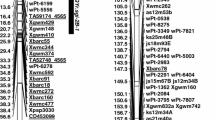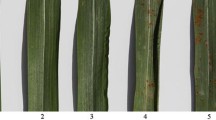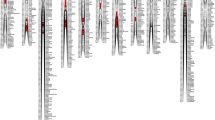Abstract
Hexaploid wheat (Triticum aestivum L.) originated about 8,000 years ago from the hybridization of tetraploid wheat with diploid Aegilops tauschii Coss. containing the D-genome. Thus, the bread wheat D-genome is evolutionary young and shows a low degree of polymorphism in the bread wheat gene pool. To increase marker density around the durable leaf rust resistance gene Lr34 located on chromosome 7DS, we used molecular information from the orthologous region in rice. Wheat expressed sequence tags (wESTs) were identified by homology with the rice genes in the interval of interest, but were monomorphic in the ‘Arina’ × ‘Forno’ mapping population. To derive new polymorphic markers, bacterial artificial chromosome (BAC) clones representing a total physical size of ∼1 Mb and belonging to four contigs were isolated from Ae. tauschii by hybridization screening with wheat ESTs. Several BAC clones were low-pass sequenced, resulting in a total of ∼560 kb of sequence. Ten microsatellite sequences were found, and three of them were polymorphic in our population and were genetically mapped close to Lr34. Comparative analysis of marker order revealed a large inversion between the rice genome and the wheat D-genome. The SWM10 microsatellite is closely linked to Lr34 and has the same allele in the three independent sources of Lr34: ‘Frontana’, ‘Chinese Spring’, and ‘Forno’, as well in most of the genotypes containing Lr34. Therefore, SWM10 is a highly useful marker to assist selection for Lr34 in breeding programs worldwide.



Similar content being viewed by others
References
Abajian C (2003) Sputnik: C program to search DNA sequence for microsatellite repeats. http://espressosoftware.com/pages/sputnik.jsp
Akhunov ED, Goodyear AW, Geng S, Qi LL, Echalier B, Gill BS, Miftahudin, Gustafson JP, Lazo G, Chao SM, Anderson OD, Linkiewicz AM, Dubcovsky J, La Rota M, Sorrells ME, Zhang DS, Nguyen HT, Kalavacharla V, Hossain K, Kianian SF, Peng JH, Lapitan NLV, Gonzalez-Hernandeiz JL, Anderson JA, Choi DW, Close TJ, Dilbirligi M, Gill KS, Walker-Simmons MK, Steber C, McGuire PE, Qualset CO, Dvorak J (2003) The organization and rate of evolution of wheat genomes are correlated with recombination rates along chromosome arms. Genome Res 13:753–763
Altschul SF, Madden TL, Schaffer AA, Zhang JH, Zhang Z, Miller W, Lipman DJ (1997) Gapped BLAST and PSI-BLAST: a new generation of protein database search programs. Nucleic Acids Res 25:3389–3402
Bennetzen JL, Ma J (2003) The genetic colinearity of rice and other cereals on the basis of genomic sequence analysis. Curr Opin Plant Biol 6:128–133
Bennetzen JL, Ramakrishna W (2002) Numerous small rearrangements of gene content, order and orientation differentiate grass genomes. Plant Mol Biol 48:821–827
Brunner S, Keller B, Feuillet C (2003) A large rearrangement involving genes and low-copy DNA interrupts the microcollinearity between rice and barley at the Rph7 locus. Genetics 164:673–683
Cregan PB, Mudge J, Fickus EW, Marek LF, Danesh D, Denny R, Shoemaker RC, Matthews BF, Jarvik T, Young ND (1999) Targeted isolation of simple sequence repeat markers through the use of bacterial artificial chromosomes. Theor Appl Genet 98:919–928
Dubcovsky J (2004) Marker-assisted selection in public breeding programs: the wheat experience. Crop Sci 44:1895–1898
Dubcovsky J, Ramakrishna W, SanMiguel PJ, Busso CS, Yan L, Shiloff BA, Bennetzen JL (2001) Comparative sequence analysis of colinear barley and rice bacterial artificial chromosomes. Plant Physiol 125:1342–1353
Dyck PL (1991) Genetics of adult-plant leaf rust resistance in Chinese Spring and sturdy wheats. Crop Sci 31:309–311
Dyck PL, Samborski DJ, Martens JW (1985) Inheritance of resistance to leaf rust and stem rust in the wheat Cultivar Glenlea. Can J Plant Path 7:351–354
Endo TR, Gill BS (1996) The deletion stocks of common wheat. J Hered 87:295–307
Feuillet C, Keller B (2002) Comparative genomics in the grass family: molecular characterization of grass genome structure and evolution. Ann Bot 89:3–10
Gupta P, Balyan H, Edwards K, Isaac P, Korzun V, Röder M, Gautier M-F, Joudrier P, Schlatter A, Dubcovsky J, De la Pena R, Khairallah M, Penner G, Hayden M, Sharp P, Keller B, Wang R, Hardouin J, Jack P, Leroy P (2002) Genetic mapping of 66 new microsatellite (SSR) loci in bread wheat. Theor Appl Genet 105:413–422
Guyomarc’h H, Sourdille P, Edwards KJ, Bernard M (2002) Studies of the transferability of microsatellites derived from Triticum tauschii to hexaploid wheat and to diploid related species using amplification, hybridization and sequence comparisons. Theor Appl Genet 105:736–744
Guyot R, Yahiaoui N, Feuillet C, Keller B (2004) In silico comparative analysis reveals a mosaic conservation of genes within a novel colinear region in wheat chromosome 1AS and rice chromosome 5S. Funct Integr Genomics 4:47–58
Huang XQ, Borner A, Roder MS, Ganal MW (2002) Assessing genetic diversity of wheat (Triticum aestivum L.) germplasm using microsatellite markers. Theor Appl Genet 105:699–707
Isidore E, Scherrer B, Chalhoub B, Feuillet C, Keller B (2005) Ancient haplotypes resulting from extensive molecular rearrangements in the wheat a genome have been maintained in species of three different ploidy levels. Genome Res 15:526–536
Kalendar R (2006) FastPCR, PCR primer design, DNA and protein tools, repeats and own database searches program. http://www.biocenter.helsinki.fi/bi/programs/fastpcr.htm
Keller B, Feuillet C, Yahiaoui N (2005) Map-based isolation of disease resistance genes from bread wheat: cloning in a supersize genome. Genet Res 85:93–100
Kolmer JA, Liu JQ (2001) Simple inheritance of partial resistance to leaf rust in two wheat cultivars. Plant Pathol 50:546–551
Lander ES, Green P, Abrahamson J, Barlow A, Daley MJ, Lincoln SE, Newburg L (1987) MAPMAKER: an interactive computer package for constructing primary genetic linkage maps of experimental and natural populations. Genomics 1:174–181
Leister D, Kurth J, Laurie DA, Yano M, Sasaki T, Devos K, Graner A, Schulze-Lefert P (1998) Rapid reorganization of resistance genes homologoues in cereal genomes. Proc Natl Acad Sci 95:370–375
Luo MC, Thomas C, You FM, Hsiao J, Ouyang S, Buell CR, Malandro M, McGuire PE, Anderson OD, Dvorak J (2003) High-throughput fingerprinting of bacterial artificial chromosomes using the snapshot labeling kit and sizing of restriction fragments by capillary electrophoresis. Genomics 82:378–389
Ma H, Singh RP (1996) Contribution of adult plant resistance gene Yr18 in protecting wheat from yellow rust. Plant Dis 80:66–69
McFadden ES, Sears ER (1946) The origin of Triticum spelta and its free-threshing hexaploid relatives. J Hered 37:81–89, 107–116
McIntosh RA (1992) Close genetic linkage of genes conferring adult-plant resistance to leaf rust and stripe rust in wheat. Plant Pathol 41:523–527
Niks RE, Rubiales D (2002) Potentially durable resistance mechanisms in plants to specialised fungal pathogens. Euphytica 124:201–216
Nilmalgoda SD, Cloutier S, Walichnowski AZ (2003) Construction and characterization of a bacterial artificial chromosome (BAC) library of hexaploid wheat (Triticum aestivum L.) and validation of genome coverage using locus-specific primers. Genome 46:870–878
Ogbonnaya FC, Halloran GM, Lagudah ES (2005) D genome of wheat—60 years from Kihara, Sears and McFadden. In: Tsunewaki K (ed) Frontiers of wheat bioscience. Kihara memorial foundation for the advancement of life sciences, Yokohama, pp205–220
Paillard S, Schnurbusch T, Winzeler M, Messmer M, Sourdille P, Abderhalden O, Keller B, Schachermayr G (2003) An integrative genetic linkage map of winter wheat (Triticum aestivum L.). Theor Appl Genet 107:1235–1242
Pestsova E, Ganal MW, Roder MS (2000) Isolation and mapping of microsatellite markers specific for the D genome of bread wheat. Genome 43:689–697
Prasad M, Varshney RK, Roy JK, Balyan HS, Gupta PK (2000) The use of microsatellites for detecting DNA polymorphism, genotype identification and genetic diversity in wheat. Theor Appl Genet 100:584–592
Röder MS, Korzun V, Wendehake K, Plaschke J, Tixier M-H, Leroy P, Ganal MW (1998) A microsatellite map of wheat. Genetics 149:2007–2023
Sakata K, Nagamura Y, Numa H, Antonio BA, Nagasaki H, Idonuma A, Watanabe W, Shimizu Y, Horiuchi I, Matsumoto T, Sasaki T, Higo K (2002) RiceGAAS: an automated annotation system and database for rice genome sequence. Nucleic Acids Res 30:98–102
Sambrook J, Russel DW (2001) Molecular cloning: a laboratory manual. Cold spring Harbor Laboratoy Press, NY, USA
Sawhney RN, Sharma JB (1999) Novel complementary genes for adult plant leaf rust resistance in a wheat stock carrying the 1BL-1RS translocation. Plant Breed 118:269–271
Schnurbusch T, Paillard S, Schori A, Messmer M, Schachermayr G, Winzeler M, Keller B (2004a) Dissection of quantitative and durable leaf rust resistance in Swiss winter wheat reveals a major resistance QTL in the Lr34 chromosomal region. Theor Appl Genet 108:477–484
Schnurbusch T, Bossolini E, Messmer M, Keller B (2004b) Tagging and validation of a major quantitative trait locus for leaf rust resistance and leaf tip necrosis in winter wheat cultivar Forno. Phytopathology 94:1036–1041
Sears ER (1966) Nullisomic-tetrasomic combinations in hexaploid wheat. In: Riley R, Lewis KR (eds) Chromosome manipulation and plant genetics. Oliver and Boyd, Edinburgh, pp 29–45
Shen B, Wang DM, McIntyre CL, Liu CJ (2005) A Chinese Spring wheat (Triticum aestivum L.) bacterial artificial chromosome library and its use in the isolation of SSR markers for targeted genome regions. Theor Appl Genet 111:1489–1494
Singh RP (1992) Association between gene Lr34 for leaf rust resistance and leaf tip necrosis in wheat. Crop Sci 32:874–878
Singh RP, Kumar N, Bandopadhyay R, Rustgi S, Sharma S, Balyan HS, Gupta PK (2006) Development and use of anchored-SSRs to study DNA polymorphism in bread wheat (Triticum aestivum L.). Mol Ecol Notes 6:296–299
Somers DJ, Isaac P, Edwards K (2004) A high density microsatellite consensus map for bread wheat (Triticum aestivum L.). Theor Appl Genet 109:1105–1114
Song Q, Shi J, Singh S, Fickus E, Costa J, Lewis J, Gill B, Ward R, Cregan P (2005) Development and mapping of microsatellite (SSR) markers in wheat. Theor Appl Genet 110:550–560
Sorrells ME, La Rota M, Bermudez-Kandianis CE, Greene RA, Kantety R, Munkvold JD, Miftahudin T, Mahmoud A, Ma X, Gustafson PJ, Qi LL, Echalier B, Gill BS, Matthews DE, Lazo GR, Chao S, Anderson OD, Edwards H, Linkiewicz AM, Dubcovsky J, Akhunov ED, Dvorak J, Zhang D, Nguyen HT, Peng J, Lapitan NLV, Gonzalez-Hernandez JL, Anderson JA, Hossain K, Kalavacharla V, Kianian SF, Choi D-W, Close TJ, Dilbirligi M, Gill KS, Steber C, Walker-Simmons MK, McGuire PE, Qualset CO (2003) Comparative DNA sequence analysis of wheat and rice genomes. Genome Res 13:1818–1827
Spielmeyer W, McIntosh RA, Kolmer J, Lagudah ES (2005) Powdery mildew resistance and Lr34/Yr18 genes for durable resistance to leaf and stripe rust cosegregate at a locus on the short arm of chromosome 7D of wheat. Theor Appl Genet 111:731–735
Stein N, Feuillet C, Wicker T, Schlagenhauf E, Keller B (2000) Subgenome chromosome walking in wheat: A 450-kb physical contig in Triticum monococcum L. spans the Lr10 resistance locus in hexaploid wheat (Triticum aestivum L.). Proc Natl Acad Sci 97:13436–13441
Suenaga K, Singh RP, Huerta-Espino J, William HM (2003) Microsatellite markers for genes Lr34/Yr18 and other quantitative trait loci for leaf rust and stripe rust resistance in bread wheat. Phytopathology 93:881–890
Vogel JP, Raab TK, Schiff C, Somerville SC (2002) PMR6, a pectate lyase-like gene required for powdery mildew susceptibility in Arabidopsis. Plant Cell 14:2095–2106
Voorrips RE (2002) Mapchart: software for the graphical presentation of linkage maps and QTLs. J Hered 93:77–78
Wicker T, Yahiaoui N, Guyot R, Schlagenhauf E, Liu ZD, Dubcovsky J, Keller B (2003) Rapid genome divergence at orthologous low molecular weight glutenin loci of the A and A(m) genomes of wheat. Plant Cell 15:1186–1197
Winzeler M, Mesterhazy A, Park RF, Bartos P, Csosz M, Goyeau H, Ittu M, Jones E, Loschenberger F, Manninger K, Pasquini M, Richter K, Rubiales D, Schachermayr G, Strzembicka A, Trottet M, Unger O, Vida G, Walther U (2000) Resistance of European winter wheat germplasm to leaf rust. Agronomie 20:783–792
Acknowledgments
We would like to thank Dr. Thomas Wicker and Dr. Edith Schlagenhauf for their bioinformatical support and Beatrice Senger, Theres Klimm and Urs Ochsner for their technical assistance. We are very thankful to Dr. Jan Dvorak and Dr. Alina Akhunova (University of California, Davis, CA, USA) for providing BAC clones and filters of the Ae. tauschii BAC library, and to Dr. Sylvie Cloutier and Dr. Andrzej Walichnowski (Cereal Research Center, Winnipeg, Canada) for providing the BAC pools of the ‘Glenlea’ library as well as wheat ESTs. For providing ESTs we also thank Dr. Olin Anderson and Dr. Curt Crossman (USDA-ARS, Albany, CA, USA), Dr. Yasunari Ogihara (Yokohama City University, Japan), Dr. Kazuhiro Sato (Okayama University, Japan), Dr. Mark Sorrells (Cornell University, Ithaca, NY, USA), Dr. Jens Stougaard (Aarhus University, Denmark), Dr. Patrick Gulick (Concordia University, Montreal, Canada), Dr. Nils Stein (IPK Gatersleben, Germany), and Dr. Robert Waugh (SCRI, Dundee, Scotland, UK). We thank Dr. Marion Röder (IPK Gatersleben, Germany) as well as TraitGenetics Inc (Gatersleben, Germany) for providing unpublished primer sequences. We are grateful to Dr. Jon Raupp (KSU, WGRC, Manhattan, KS, USA) for providing plant material. Finally we would like to thank Dr. Nabila Yahiaoui and Dr. Jan Dvorak for critical reading of the manuscript. This work was supported by the Swiss National Science Foundation (SNF grant 3100A0-105620) and by the Indo–Swiss Collaboration in Biotechnology (ISCB, project WN7). The authors declare that the experiments conducted for this publication comply with the current laws of Switzerland. Eligio Bossolini and Simon G. Krattinger contributed equally to the work.
Author information
Authors and Affiliations
Corresponding author
Additional information
Communicated by A. Graner.
Rights and permissions
About this article
Cite this article
Bossolini, E., Krattinger, S.G. & Keller, B. Development of simple sequence repeat markers specific for the Lr34 resistance region of wheat using sequence information from rice and Aegilops tauschii . Theor Appl Genet 113, 1049–1062 (2006). https://doi.org/10.1007/s00122-006-0364-5
Received:
Accepted:
Published:
Issue Date:
DOI: https://doi.org/10.1007/s00122-006-0364-5




